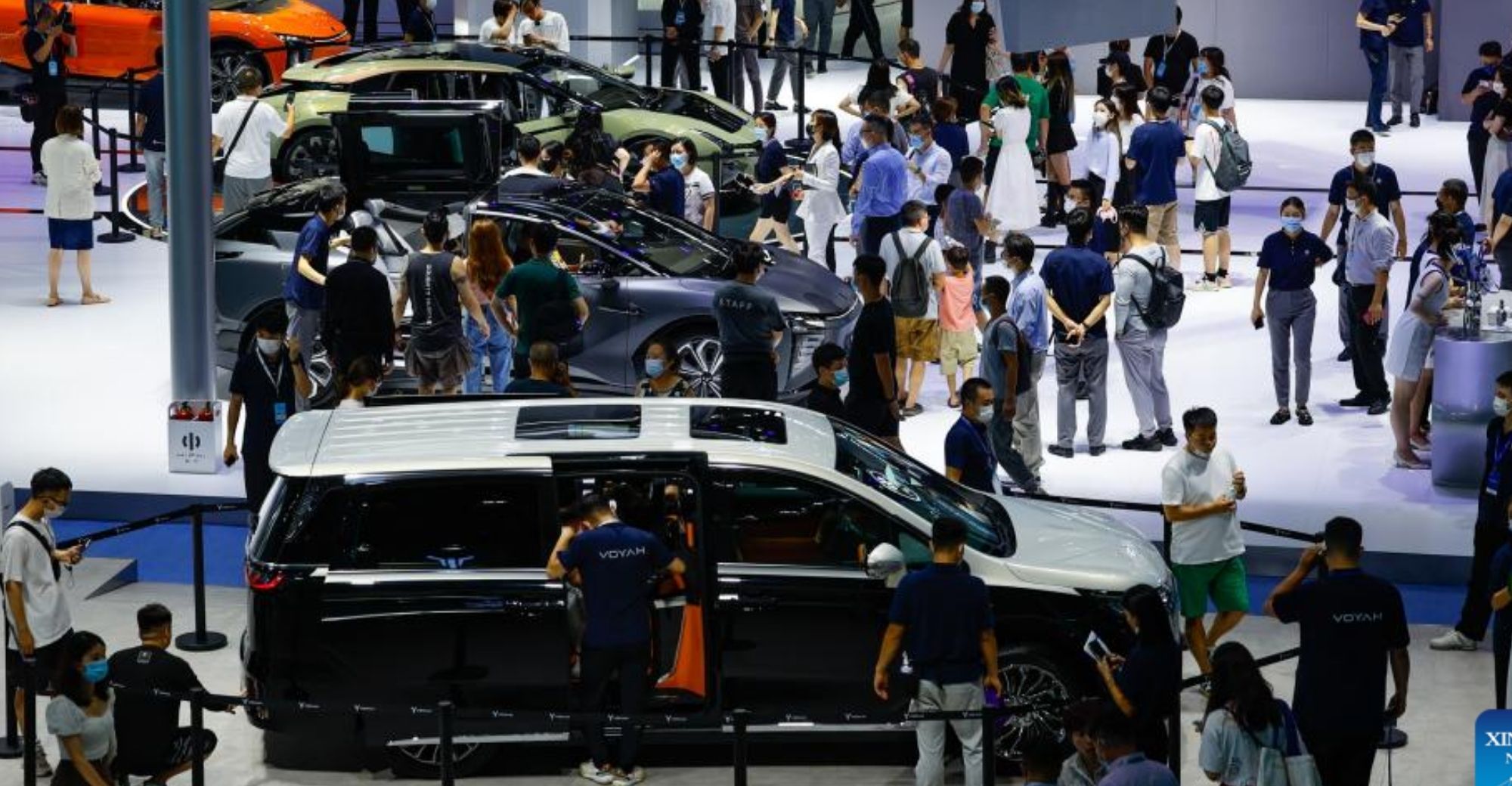Navigating The China Market: The Struggles Faced By BMW, Porsche, And Other Automakers

Table of Contents
Intense Domestic Competition
The Chinese automotive market is fiercely competitive, posing a major hurdle for foreign automakers. This intense competition stems from two primary sources: the rise of powerful domestic brands and the resulting price wars and market saturation.
Rise of Chinese Auto Brands
The rapid ascent of Chinese auto brands like BYD, NIO, and Xpeng represents a significant threat to established foreign players. These domestic brands leverage several key advantages:
- Increased market share of Chinese brands: Domestic brands are steadily gaining market share, eating into the traditional dominance of international manufacturers. This is driven by factors such as increased consumer trust and a growing preference for locally produced vehicles.
- Technological innovation in electric vehicles (EVs): Chinese automakers are at the forefront of EV innovation, offering competitive vehicles with advanced features and technologies, often at more attractive price points. This is particularly challenging for established players who may be slower to adapt to the rapidly evolving EV landscape.
- Government incentives favoring domestic automakers: The Chinese government actively supports domestic automakers through various subsidies, tax breaks, and favorable regulations, creating an uneven playing field for foreign competitors.
- Strong brand loyalty amongst Chinese consumers: A growing sense of national pride is fostering strong brand loyalty towards domestic brands, making it harder for foreign automakers to penetrate the market. This requires targeted strategies to build trust and brand recognition.
Price Wars and Market Saturation
The highly competitive nature of the Chinese automotive market has led to frequent price wars, putting immense pressure on profit margins for foreign brands.
- Aggressive pricing strategies by Chinese brands: Domestic brands often employ aggressive pricing strategies, undercutting foreign competitors to gain market share.
- Pressure to offer competitive pricing and features: Foreign automakers are forced to offer highly competitive pricing and feature sets to remain relevant, squeezing profit margins.
- Challenges in maintaining high profit margins: The price wars make it incredibly difficult for foreign automakers to maintain the high profit margins they are accustomed to in other markets.
- Increased pressure to localize production and supply chains: To become more cost-competitive, foreign brands face increasing pressure to establish local manufacturing facilities and supply chains, which requires substantial investment.
Regulatory and Political Hurdles
Navigating the Chinese automotive market involves overcoming significant regulatory and political hurdles.
Navigating Complex Regulations
China's automotive industry is subject to a complex web of regulations, which presents a substantial challenge for foreign automakers.
- Complex import and export regulations: Importing and exporting vehicles and parts can be a bureaucratic nightmare, involving numerous permits, licenses, and inspections.
- Stringent environmental regulations and emission standards: China has implemented strict emission standards and environmental regulations, requiring significant investments in technology and compliance.
- Bureaucratic hurdles in obtaining necessary licenses and approvals: Obtaining the necessary licenses and approvals to operate in the Chinese market can be a lengthy and complicated process.
- Changing regulations and policy shifts: The regulatory landscape is constantly evolving, requiring foreign automakers to remain vigilant and adaptable.
Geopolitical Risks and Trade Tensions
The geopolitical relationship between China and other countries can significantly impact the operating environment for foreign automakers.
- Impact of trade wars and tariffs: Trade disputes and tariffs can impose significant costs and uncertainties for foreign automakers operating in China.
- Political instability and its influence on business operations: Political instability and changes in government policy can create uncertainty and disrupt business operations.
- Concerns about intellectual property protection: Foreign automakers have concerns about protecting their intellectual property in China.
- Navigating potential sanctions and trade restrictions: Foreign automakers must be aware of and adapt to potential sanctions and trade restrictions.
Understanding Consumer Preferences
Success in the Chinese automotive market requires a profound understanding of local consumer preferences.
Localized Marketing and Product Adaptation
Simply translating marketing materials isn't enough; foreign automakers need to deeply understand and cater to the specific preferences of Chinese consumers.
- Importance of localized marketing campaigns: Marketing campaigns must resonate with the local culture and values.
- Tailoring product features and designs to suit local tastes: Product design and features should be adapted to meet the specific needs and preferences of Chinese consumers.
- Understanding the preferences of different demographic groups: The Chinese consumer base is diverse, requiring targeted marketing strategies for different demographic groups.
- Effective use of digital marketing channels: Leveraging digital marketing channels, like WeChat and other social media platforms, is crucial for reaching Chinese consumers effectively.
Building Brand Trust and Reputation
Establishing trust and a strong brand reputation is paramount for success in the Chinese market.
- Building a positive brand image: A positive brand image is essential for gaining consumer trust and loyalty.
- Providing exceptional customer service: Providing excellent customer service is vital for building long-term relationships with customers.
- Addressing consumer concerns and complaints effectively: Addressing consumer concerns and complaints promptly and effectively is crucial for maintaining a positive brand image.
- Leveraging social media and online platforms to manage reputation: Actively managing the brand's online reputation through social media and other online platforms is crucial for success.
Conclusion
The China market presents both immense opportunities and significant challenges for international automakers like BMW and Porsche. Successfully navigating this complex landscape requires a strategic approach that addresses intense domestic competition, regulatory hurdles, and the unique preferences of Chinese consumers. Overcoming these China Market Automotive Challenges necessitates a deep understanding of the local market dynamics, investment in localized strategies, and a commitment to building strong relationships with both consumers and the government. Mastering these elements will be crucial for long-term success in the lucrative, but demanding, China Market Automotive sector. To learn more about effective strategies for conquering the China market, continue your research into the specific challenges and opportunities facing foreign automakers. Don't hesitate to delve deeper into the intricacies of the China Market Automotive Challenges and discover solutions for sustained growth.

Featured Posts
-
 Steekincident Groningen Meer Informatie Over De Aanhouding Van Malek F
May 02, 2025
Steekincident Groningen Meer Informatie Over De Aanhouding Van Malek F
May 02, 2025 -
 Ps 5 Vs Xbox Series X S A Detailed Us Sales Comparison
May 02, 2025
Ps 5 Vs Xbox Series X S A Detailed Us Sales Comparison
May 02, 2025 -
 Xrp Up 400 In Q Insert Quarter Investment Opportunity Or Risk
May 02, 2025
Xrp Up 400 In Q Insert Quarter Investment Opportunity Or Risk
May 02, 2025 -
 Remembering Poppy A Heartfelt Tribute From Her Family
May 02, 2025
Remembering Poppy A Heartfelt Tribute From Her Family
May 02, 2025 -
 The End Of A School Desegregation Order A Look At The Legal And Social Ramifications
May 02, 2025
The End Of A School Desegregation Order A Look At The Legal And Social Ramifications
May 02, 2025
